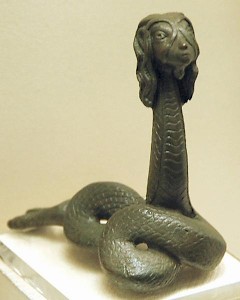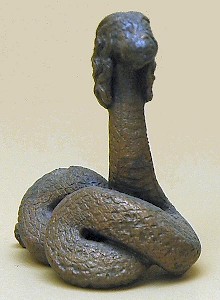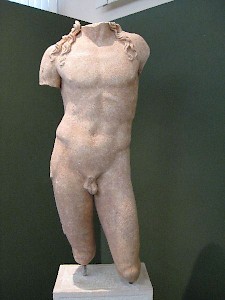Glykon
Glykon or Glycon: snake god, associated with the Greek prophet Alexander of Abonutichus.

The cult of the snake god Glykon was introduced in in the mid-second century CE by the Greek prophet Alexander of Abonutichus. This is, at least, what we can deduce from the writings by the Greek author Lucian of Samosata (c.120-c.190), who devoted an extremely hostile (and extremely amusing) pamphlet to the charlatan: Alexander, the Oracle Monger.
Ignoring Lucian's bias, we can probably accept from his work that the cult -or at least the snake Alexander venerated- originated in Macedonia, where similar snake cults were already known in the fourth century BCE.note The prophet Alexander brought the god, a very large snake, to his home town Abonutichus in Paphlagonia and built a temple, which became an important oracle. There is a literary parallel here to the arrival of Asclepius, also venerated as a snake, in Rome.
In Abonutichus, Glykon was venerated as New Asclepius, and seems to have gained great renown when he protected the believers during the plague of the late 160s with the magical spell "Long-tressed Phoebus shall dispell the plague-cloud", a spell not only mentioned by Lucian, but also discovered on an inscription from Antioch, the capital of ancient Syria.

However, the breakthrough may have been earlier, because in 160, the oracle of Glykon had already found a protector in the governor of Asia, Publius Mummius Sisenna Rutilianus (consul 146), who was to become son-in-law of the prophet. Abonutichus, once a small village of fishermen, became an important town and accepted another name, Ionopolis, "Greek city". Today, it is still called Inebolu. (A Turkish friend of the author of the present article once told him that in the early 1970s, when he was hunting in the hills near Inebolu, people warned him for a magical snake.)
There is a very interesting inscription from Caesarea Trocetta (in western Asia Minor) that mentions a priest of Apollo named "Miletus, son of Glykon of Paphlagonia". Perhaps, this man's parents were unable to have children and visited the temple, after which the woman became pregnant (cf. above, Olympias). Children born after divine intervention often had names that commemorated the god's help (cf. the story told by Luke about the birth of John the Baptist). To a certain extent, this inscription confirms the statement of Lucian about the charlatan Alexander's admittedly more worldly means to help women become pregnant.
Several dedications, statuettes and coins, found in the entire area between the Danube and Euphrates, prove that the cult of Glykon remained alive until at least a century after the death of the prophet in c.170. The snake is shown with a human head, and it is possible that there is a link to the cult of Sarapis, who was also represented in this way. It may be significant that Sarapis was identified with Asclepius too.

Alexander, who was recognized as son of Podalirus and grandson of Asclepius, continued to receive religious honors and was considered to be the god's prophet even after the end of his earthly existence. His success in establishing a new cult seems symptomatic of the shift in religious attitude in the late second and third centuries, away from the traditional beliefs, to new cults, of which the best-known is Christianity.
Literature
- C.P. Jones, Culture and Society in Lucian (1986)
- M.S. Kos, "Draco and the survival of the snake cult in the central Balkans", in: Tyche 6 (1991)